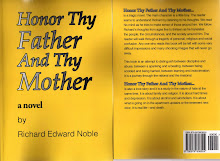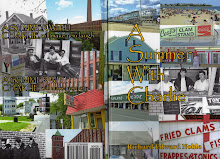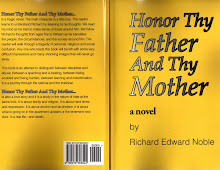The Eastpointer
What about a Storm?
By Richard E. Noble
As most of us who were around in the "good old days" know, the good old days weren't really all that "good." I was talking with some folks the other evening who had never been seafood workers. They wanted to know what we used to do with our valuable oyster boats when a storm was threatening off shore.
Pictures began to pop into my mind, but the first thing I remembered was that our old oyster boats were not all that valuable. We rented our first oyster boat for a-bag-a-day. We called the boat, bail-a-little sail-a-little. The boat leaked so badly that I had to take a break from tonging every half hour or so, walk to the back of the boat and start bailing it out. Our bail bucket used to be an old Clorox bottle or plastic milk jug with the cap screwed back on and the bottom cut out.
Many oystermen that I knew didn't own an oyster boat or a motor. They rented their boat and motor from the dealer who they worked for - one bag of oysters for the boat and one bag for the motor. Some other oystermen shared one rented boat. Some dealers had a small fleet of old boats and motors that they rented. At one point in our career, my wife and I owned three oyster boats that we rented out to other aspiring self-employed businessmen in the "trade." It was somewhat of a losing proposition. Most of the time, the fellow who rented a boat would get behind on his rent. He would then unload his oysters down on Cat Point or elsewhere and when he came back to tie out the boat, he would have no money to pay.
But the boats were cheap. I think we bought our old boats for between $150 and $250. For most of our career we never had a trailer for any of our oyster boats - and most other folks we knew didn't either.
After many storms we simply joined the large crowd of oystermen who were digging their boats out of the sand along the shore line. At that time there were at least 1500 registered oysterman. The channel in Eastpoint could have five to six hundred boats crammed in that tiny stretch of beach. If you didn't get your motor off your boat in time, you would have to take it apart, get all the salty water out of the carburetor and squirt lots of oil into the cylinder heads, get some new spark plugs and you were back in business again within the week.
If it started blowing unexpectedly during the night, I would crawl out of bed, hop in the truck and head down to the shore.
There was a time when there was no breakwater in Eastpoint and every stormy night the shore along highway 98 would be lined with pickup trucks. They would shine their headlights on their boat to make sure another boat hadn't “drug” anchor and was now rubbing up against theirs. If that eventuality did happen, the owner of the endangered boat would have to wade or swim out to his boat, crank it up, move it and re-set his anchors. If it was raining, which was usually the case, and you couldn't afford a battery and an automatic bilge pump, you would have to wade out to your boat and bail it out periodically. Sometime it would get too windy and too rough and all us oystermen would just sit there and count the boats as they went under.
Several times in my own career, I remember wading out to my boat with the wind blowing and the waves crashing, and unscrewing my motor from the stern and carrying my 40 horse Johnson to shore on my shoulder. The boat might go under but at least I would have my motor.
A stormy night in Eastpoint meant glowing headlight beams filled with the sparkle of raindrops, cigarettes flickering behind each steering wheel, and a host of invisible worried, sleepy faces set and determined to face Mother Nature and whatever she had in mind for their future.
When a big storm was announced to be on its way, pickup trucks would be along every bank dragging oyster boats up on the hill as far as they could get them. The trunk of every old car would have the foot of an outboard dangling. Others would be out in the woods hacking down small cypress trees. The cypress trees would be sunk into the mud and used as mooring posts for your old boat if you wanted to take your chances that it wouldn't blow as bad as they said it would.
Digging out your boat after a big storm was a rather strange experience. I remember my wife and I were standing on the beach looking at our old boat that had washed up 300 yards from where we had it moored. Old Pappy Millender came up beside us. He looked at our faces. We hadn't said a word.
"Yeah but," he said. "Sure it looks bad now but you'll have it up and running before the week is out and you won't even remember today. What you want to think about today is the beautiful sun peeking up on the horizon on a foggy morning as you're heading out to work, the cool breeze blowing in your face, the clunking of them oysters being tossed into a metal bagging can. What you will remember tomorrow, is all the good times and all the fun that you have had making your living right out there on this beautiful bay with nobody telling you what to do, or how fast you have to move, or when you have to leave, or how hard you have to work. Take my word - you'll forget about today and you will remember the good times and all those good days."
And so it was!
Hobo-ing America and A Summer with Charlie are books written by Richard E. Noble, a freelance writer who has lived in Franklin County for over thirty years. Both books are now available on Amazon.com. If you would like to stock my books in your store or business, contact me at 670-8076 or e-mail me at richardedwardnoble@gtcom.net
skip to main |
skip to sidebar


G.E. Nordell's List of Labor History books
Search This Blog
Popular Posts
-
Bea’s Sandwich Shop Lawrence, Mass - My Hometown By Richard E. Noble Bea’s sandwich shop was a big memory for those of us...
-
John Pierpont Morgan 1837- 1913 By Richard E. Noble “Morgan the Magnificent - If ever there thrived a money potentate whose fortune was p...
-
Jews, God and History By Max I. Dimont Book Review By Richard Edward Noble Max I. Dimont is an ex-shoe salesman and unskilled la...
-
Social Security Commentary By Richard E. Noble The original Social Security legislation was passed in 1935. It covered employees w...
-
IF I WERE A BUTTERFLY By Richard E. Noble If I were a butterfly, I could flap my wings, and fly from flower to flower... Hour... upon hour ....
-
The Hobo Philosopher Rice Cakes – Yummy, Yummy. By Richard E. Noble My wife, over the past 30 years, has probably been on every di...
-
Politically Incorrect Humor/Commentary By Richard E. Noble Obviously, I grew up in the age of political incorrectness. Clearly I was raised ...
-
The Eastpointer Why do mullet jump? By Richard E. Noble Mullet has been a staple of life for decades here in Franklin County. Most other pl...
-
Lawrence – My Hometown Lennie’s on the Turnpike Richard E. Noble Being a jazz buff from early on my favorite nightspot was Lennie’s on the T...
-
Lawrence - My Hometown The Den Rock Drive-in By Richard E. Noble The Den Rock drive-in was on route 114 before the Den restaurant and pa...
Hobo Notes
Licensed book sellers and distributors - buy my books wholesale
Books by Richard Edward Noble. Click on covers below for more info and purchasing instructions.
Bloggin' Be My Life
It's All About Love
A Little Something
Bits and Pieces
A Baker's Dozen
Cat Point - and Them Dang Oyster People
The Eastpointer
A Summer with Charlie - Lawrence
Hobo-ing America
"Just Hangin' Out Ma"
That Old Gang of Mine
Come On-A My House
Standing on the Corner is # 6 in the lawrence My Hometown series.
Honor Thy Father and Thy Mother
Noble Notes on Famous Folks
Mein Kampf - An Analysis of Book One
America on Strike
Talk Radio - Lawrence, Ma. WCCM
Richard Edward Noble

About Me

- Richard Edward Noble
- MY NAME IS RICHARD EDWARD NOBLE. I AM A FREELANCE WRITER AND I HAVE PUBLISHED 12 BOOKS:"THE EASTPOINTER" - SELECTIONS FROM AWARD WINNING NEWSPAPER COLUMN - "A LITTLE SOMETHING" - POETRY WITH PROSE -"HONOR THY FATHER AND THY MOTHER" - A NOVEL ABOUT GROWING UP IN THE NEW ENGLAND MILL TOWN OF LAWRENCE, MASS, "HOBO-ING AMERICA" - A WORKINGMAN'S TOUR OF THE U.S.A. - "A SUMMER WITH CHARLIE" - THE STORY OF A YOUNG SAILOR'S LAST DAYS AT SALISBURY BEACH, "NOBLE NOTES ON FAMOUS FOLKS" - HUMOROUS ANECDOTES ON FAMOUS FOLKS IN HISTORY, "AMERICA ON STRIKE" HISTORY BOOK - A SURVEY OF LABOR STRIKES IN AMERICA; "A BAKER'S DOZEN" A BOOK OF HUMOROUS SHORT STORIES; "JUST HANGIN' OUT, MA" - GROWING UP IN THE 40'S, 50'S AND 60'S IN LAWRENCE, MY HOMETOWN, "TENEMENT DWELLERS" - SEQUEL TO JUST HANGIN OUT, MA; MEIN KAMPF - ANALYSIS OF BOOK ONE - HISTORY. CAT POINT - AND THEM DANG OYSTER PEOPLE - SEQUEL TO THE EASTPOINTER All 12 BOOKS ARE AVAILABLE ON AMAZON.COM, BARNES AND NOBLE AND OTHER INTERNET SOURCES OR FROM NOBLE PUBLISHING. ALL 12 OF MY BOOKS ARE NOW ON KINDLE AT BARGAIN PRICES TOO. IF YOU WOULD LIKE MORE INFORMATION ABOUT DISCOUNTS AND SPECIAL OFFERS E-MAIL ME. MY EMAIL IS ON MY PROFILE PAGE.
Robert Reich
Come Home America
Darcia Helle - "No Justice"
25 GreatThinkers Everybody Should Read
Followers
Writer's journal
My Blog List
Blog Archive
-
▼
2008
(164)
-
▼
May
(21)
- John Tyler
- Bouncer Genius and God
- The EastpointerWhat about a Storm?By Richard E. No...
- Sherman, Clayton, Norris-LaGuardiaStriking America...
- Mein KampfChapter 13 Part 3By Richard E. Noble ...
- Galileo vs Aristotle
- Sigmund Freud (1856-1939) By Richard E. Noble...
- The EastpointerBuying a ShowerBy Richard E. Noble ...
- Does Anybody Know There's a War Going On!Commentar...
- The Bonus Army of 1932Striking AmericaBy Richard E...
- John BrownHero or VillainBy Richard E. Noble ...
- The EastpointerUnemployment and My Depression Ment...
- THE SYNAGOGUE Commentary ...
- Martin Van Buren (President from 1836-1840) By Ric...
- One Nation - divisible!CommentaryBy Richard E. Nob...
- Descartes (1596-1650 A.D.)PhilosopherBy Richard E....
- Mein KampfChapter 13 Part IIMy personal thoughts a...
- Oh How She'll Miss Me
- Politically IncorrectHumor/CommentaryBy Richard E....
- Laplace (1749-1827) ScientistBy Richard E. Noble ...
- The EastpointerMeatballs make for poor PolicyBy Ri...
-
▼
May
(21)



































